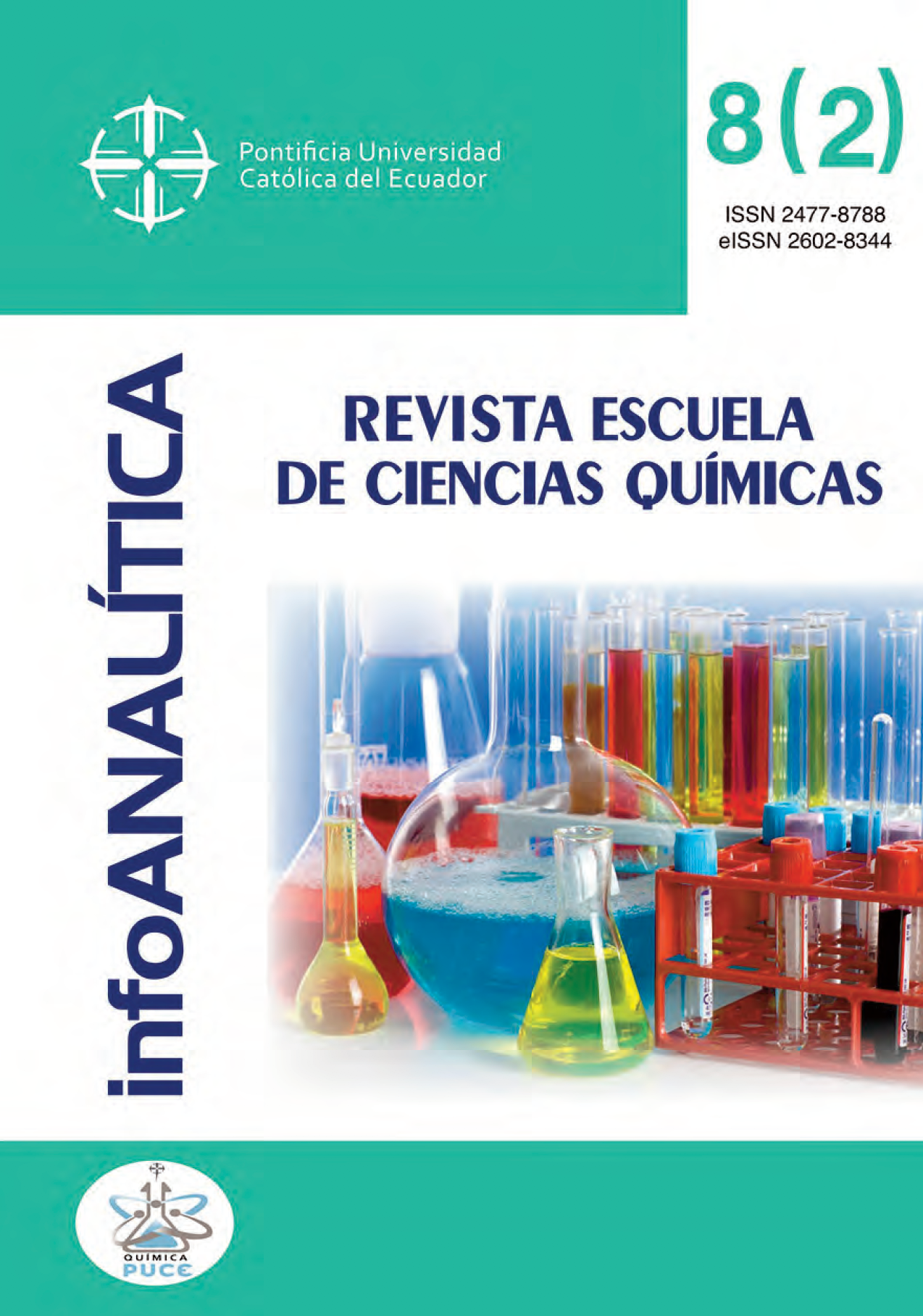Infrared spectroscopy (FTIR) analisys of the carob tree exudate Prosopis juliflora (FABACEAE)
Main Article Content
Abstract
Carob tree gum is an exudate obtained from the stems and branches of Prosopis trees. It is a natural product with potential applications in food, pharmaceutical, cosmetic industry, etc. It is found in dry and semi dry regions of Ecuador. In the present work, samples originated from Prosopis juliflora tree, collected from three zones of Manabí, province of Ecuador: Bahía de Caráquez (Zone 1), Portoviejo (Zone 2) and Puerto López (Zone 3), and one sample of arabic gum, food grade from Acacia senegal tree used as reference, were analyzed by infrared spectroscopy, to obtain and compare the spectrums of the each one of the samples. Infrared spectrums of both gums were obtained and compared with bibliography. The FTIR spectra exhibited a good correlation between the two types of gums and with the literature; an analytical comparison was made to obtain the correlation percentage between both gums. The results were 80.37, 79.83 and 79.66 % for 1, 2 and 3 zones, respectively. Thus, a research line is open for the possible use of carob gum, as a new alternative and accessible, instead of arabic gum.
Downloads
Article Details
- The authors agree to respect the academic information of other authors, and to assign the copyrights to the journal infoANALÍTICA, so that the article can be edited, published and distributed.
- The content of the scientific articles and the publications that appear in the journal is the exclusive responsibility of their authors. The distribution of the articles published in the infoANALÍTICA Journal is done under a Creative Commons Reconocimiento-CompartirIgual 4.0 Internacional License.
References
Armijos, S. (2016). Bebidas. El sector se inclina a lo natural. Vistazo, Proyectos Especiales Industrias. Recuperado de: http://anfab.com/wp/wp-content/uploads/2016/08/SUPLEMENTO-REVISTA-VISTAZO-agosto-2016-386.pdf
Bashir, M. y Haripriya, S. (2016). Assessment of physical and structural characteristics of almond gum. International Journal of Biological Macromolecules. 93, 476-482.
Burghardt, A., Brizuela, M., Pía, M., Albán, L. y Palacios, R. (2010). Análisis numérico de las especies de Prosopis L. (Fabaceae) de las costas de Perú y Ecuador. Revista Peruana de Biología. 17(3), 317-323.
Elbadawi, A., Alsabah, Y. y Abuelhassan, H. (2018). Physical and Electrical Properties of Gum Arabic. En A. Abdalbasit (Ed.). Gum Arabic: Structure, Properties, Application and Economics (pp. 75-89). London: Academic Press. Elsevier.
Goswami, S. y Naik, S. (2014). Natural gums and its pharmaceutical application. Journal of Scientific and Innovative Research. 3(1), 112-121.
Hassan, M. (2008). Comparison of the Physiochemical Properties of Gum Arabic (Acacia Senegal L.) Produced in Sandy and Gardude soils in Sudan. (Tesis de Maestria). Universidad de Gezira. Egipto.
Instituto Nacional de Meteorología e Hidrología Ecuador, Inamhi. (2018). Anuarios Meteorológicos. Inamhi. Recuperado de: http://www.serviciometeorologico.gob.ec/docum_institucion/anuarios/meteorologicos/
Instituto Químico Biológico, IBQ. (2014). Proantocianidinas. IBQ España. Recuperado de: http://www.iqb.es/monografia/fichas/proantocianina.htm
Kauther, A. y Hussien, D. (2018). Physicochemical and Funcional Properties of the Gum Arabic from Acacia Senegal. Annals. Food Science and Technology. 19(1), 27-34.
López, Y., Córdova, R., Goycoolea, F., Valdez, M., Onofre, J. y Mendoza, J. (2012). Classification and physicochemical characterization of mesquite gum (Prosopis spp.). Food Hydrocolloids. 26, 159-166.
López, Y., Goycoolea, F. y Wang, W. (2009). Other exudates: tragancanth, karaya, mesquite gum and larchwood arabinogalactan. En G. Phillips y P. Williams (Ed.). Handbook of Hydrocolloids (pp. 495-534) Cambridge: Woodhead Publishing.
Mohammedelnour, A., Mirghani, M., Kabbashi, N., Alam, Z., Musa, H. y Abdullah, A. (2017). Effect of solvent types on phenolics content and antioxidant activities of Acacia polyacantha gum. International Food Research Journal. 24, 369-377.
Ozcan, T., Akpinar, A., Ersan, L. y Delikanli, B. (2014). Phenolics in Human Health. International Journal of Chemical Engineering and Applications. 5(5), 393-396.
Palencia, M. (2018). Functional transformation of Fourier-transform mid-infrared spectrum for improving spectral specificity by simple algorithm based on wavelet-like functions. Journal of Advanced Research. 14, 53-62.
Rieppo, L., Saarakkala, S., Närhi, T., Helminen, H., Jurvelin, J. y Rieppo, J. (2012). Application of second derivative spectroscopy for increasing molecular specificity of Fourier Transform infrared spectroscopic imaging of articular cartilage. Osteoarthritis Research Society International. 20(5), 451-459.
Sibaja, R. (2015). Propiedades Fisicoquímicas y Funcionales de las Gomas de Acacia cochliacantha y Acacia farnesiana. (Tesis de Doctorado). Instituto Politécnico Nacional. México.
Udo, I., Odoemelam, S. y Okon, E. (2017). Physicochemical and FTIR studies on Acacia senegal and Anacardium occidentale blends. Journal of Industrial and Environmental Chemistry. 1(1), 31-35.
Vasile, F., Romero A., Judis, M. y Mazzobre, M. (2016). Prosopis alba exudate gum as excipient for improving fish oil stability in alginate–chitosan beads. Food Chemistry. 190, 1093-1101.
Vasile, F., Romero, A., Judis, M., Mattalloni, M., Virgolini, M. y Mazzobre, M. (2019). Phenolics composition, antioxidant properties and toxicological assessment of Prosopis alba exudate gum. Food Chemistry. 285, 369-379.
Verbist, K., Santibañez, F., Gabriels, D. y Soto, G. (2010). Atlas de zonas áridas de América Latina y el Caribe. Recuperado de https://unesdoc.unesco.org/ark:/48223/pf0000216333
Vernon, E., Beristain, C. y Pedroza, R. (2000). Mesquite gum (Prosopis gum). Developments in Food Science. 41, 217-238.
Yebeyen, D., Lemenihb, M. y Feleke, S. (2009). Characteristics and quality of gum arabic from naturally grown Acacia senegal (Linne) Willd. trees in the Central Rift Valley of Ethiopia. Food Hydrocolloids. 23, 175-180.

